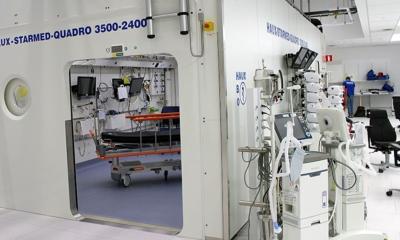Melanoma treatment
Dermatology develops an effective immunotherapy against solid cancer
Melanomas account among the eight most frequent deadly cancers in Europe and Northern America. Two major clinical criteria separate melanomas from most other cancers: the risk to die from a melanoma is a question of being less or more than 1 mm – and not a question of cm. About 95% of patients with melanomas ≤0.5 mm in thickness are clinically cured by early detection and appropriate melanoma surgery. In contrast, melanomas of ≥4 mm in thickness used to kill almost half of the patients, even after appropriate surgical dermatology. Importantly, many data show that, until now, appropriate surgical dermatology is even the most appropriate treatment for single melanoma metastases.

The second unique aspect of metastatic melanomas is their electively low sensitivity to chemotherapy. Even though effective in single patients, no trial with either chemotherapy or immune-chemotherapy prolonged patient survival largely over the time achieved by classical monotherapy with darcabacine.
Now, dermatology shows, for the first time, that immunotherapy of solid cancers can significantly improve the survival of patients with metastatic disease – and this in a surprisingly high percentage of patients. The new insights and advances show an entirely novel, much brighter view for patients with advanced and metastatic melanomas. These insights have a major reach-out, beyond dermatology, for almost all oncological disciplines. These achievements also redefine an entirely novel responsibility and serious task of dermatologists worldwide in treating cancer patients. Below a few major aspects presented during the 25th EADV Congress are summarised:
Surgical dermatology for melanoma
A plenary presentation by Prof. Dr. T. Johnson, discussed data of a highly debated academic manuscript published 2 years ago in the New England Journal of Medicine. The current data clearly say that patients who get early excision of micrometastases in their draining lymph nodes have a significantly better 12-year survival than patients who do not get this procedure.
Targeted melanoma therapy
A fine-tuned network of signalling molecules tells cells how to grow in a healthy environment. Publicly funded academic research uncovered aberrant signalling events that are capable of driving benign pigment cells to become melanomas. These academic findings now allowed developing drugs that are highly efficient as melanoma therapy. As single therapy, such drugs frequently help only for short periods and metastases rapidly return. New insights into the aberrant signalling events during treatment now allowed developing more efficient combination therapies that seem to help a significant number of patients for at least three years. Importantly, early discovery of metastases by dermatologists strongly improves the long-term prognosis of the patients. Dermatologists also have to recognize and treat the novel side effects, most of them affecting the skin. A caveat of these therapies is that metastases tend to rapidly return, when treatment is interrupted.
The breakthrough for immunotherapy for solid cancers
After decades of research, metastatic melanoma is now the first cancer that can be treated by immunotherapy. Again, the basis of this therapy was developed by publicly funded research and the industry used this knowledge to then translate these insights as melanoma-immunotherapy, as no other treatment was available for metastatic melanoma. Retrospective analysis of many hundreds of patients receiving such an immunotherapy now uncovered the critical importance of starting the immunotherapy for metastatic melanoma as early as possible. It seems that immunotherapies with antibodies directed against a molecule called programmed death 1 or PD1 can help more than half of the patients for at least two years if they have a low metastatic burden and a well-functioning immune system.
The novel immunotherapies also open the door for other hopes: one is that combination of immunotherapies can further improve the efficiency. The other is that the therapy no longer needs cancer eradication, but that immunotherapies may drive cancer metastases into a ‘dormant state,’ where they remain stable and the growth is halted.
The novel tasks for dermatologists worldwide
This breakthrough in melanoma immunotherapy has several major consequences for dermatologists:
1. Following primary excision, they have to closely follow their melanoma patients, do follow up investigations and detect metastatic disease as early as possible.
2. They must learn to correctly perform targeted therapies and melanoma immunotherapies: how, what, when.
3. Appropriate recognition and appropriate treatment of the immune-mediated side effects; other disciplines are starting only now to perform these immunotherapies for other cancers.
4. In case of single recurrent metastases, excision becomes important, as in many patients with immunotherapy only single metastases recur, while the others tend to remain stable.
The reach-out into many medical disciplines
The discovery that melanoma, a solid cancer, can be treated by immunotherapy has now initiated studies in many other tumour entities and this immunotherapy will be helpful in a large variety of cancers entities. Thus, many cancer patients could be treated in the future by cancer immunotherapies.
The reach-out of cancer-immunotherapies into many medical disciplines – a caveat
The annual costs of novel cancer therapies are frequently in the range of 100.000 € per patient; for combination therapies the prices may double. As we now become capable to treat a large number of cancer patients, either by targeted therapies or by immunotherapies, the pure annual drug costs (not the treatment costs), will be in the range of 100.000–200.000 € per patient. As discussed by a group of 100 oncologists worldwide* and many specialists, no society will be capable of affording drug costs of this magnitude. Even treatments that are 3-times less expensive and restricted to a very small number of patients cannot longer be covered by all rich countries*. Patients are again dying even though they could receive a therapy*. Thus, a new deal is needed to make efficient cancer therapies also available to those who need them. This is also important as the development of the novel cancer therapies available and the future development of cancer therapies cannot be imagined without the academic research that is funded by the patients – as taxpayers.
PROFILE:
Prof. Dr. Martin Röcken was born in May 1956. He studied in Munich, Brussels, Berlin and Lausanne. After his residency in dermatology at the City Hospital Munich Schwabing, Germany, he started as postdoctoral fellow at the Department of Dermatology at the University of Geneva, Switzerland, from 1988–1991. After two years as visiting scientist at the Laboratory of Immunology, National Institutes of Health in Bethesda, USA, he returned in 1993 as Associate Professor of Dermatology to the Department of Dermatology at the Ludwig Maximilians University Munich, where he became a regular Professor in 1998. Since 2002 he is the Chair of the Department of Dermatology at the Eberhard Karls University in Tübingen, Germany. He is executive board member of the German Society of Dermatology (DDG), member of the German Academy of Sciences Leopoldina and Chair of the Scientific Programming Committee of the European Academy of Dermatology and Venereology (EADV). His clinical and research focus includes the autoimmune diseases of the skin, psoriasis and pathogen-host-interactions during infectious diseases including HIV-infection, onco-dermatology, tumor immunology and especially development of tumor immune therapies.
Literature:
*Experts in Chronic Myeloid Leukemia. The price of drugs for chronic myeloid leukemia (CML) is a reflection of the unsustainable prices of cancer drugs: from the perspective of a large group of CML experts. Blood. 2013; 121: 4439-42.
Source: EADV
05.10.2016











